In this paper, an analysis of the selection of integrated template structures (ITSs) for Arctic environments is presented. An analysis of several actual projects has been carried out. One of the important parts of this work was devoted to the requirements on ITSs conceived in relevant standards. The main elements of subsea-production modules, including their specific characteristics and components, are considered in the work.
Introduction
The Terra Nova and White Rose fields, on the Grand Banks of Newfoundland, have been developed; other offshore projects are being prepared, such as Goliat and Skrugard in Northern Norway. These projects can be considered as true stepping stones toward oil and gas development in the Arctic region. The harsh conditions of the Arctic environment (low temperatures, icing, snow, fog, and polar night) lead to weather limitations, required winterization, complex logistics, and difficult emergency evacuation and rescue organization.
The severe climatic conditions make the development of Arctic offshore and subsea marine operations extremel challenging. Features affecting safe offshore operations, subsea construction work, and field development are many, and are outlined in the complete paper. Several such factors of great importance are winds, waves, currents, and polar lows (low-pressure weather phenomena that appear when there are changes of cold Arctic air over the sea). Operational criteria are based on several weather parameters.
Technical Requirements for the Arctic/Sub-Arctic Region
Arctic completions are basically driven by economics. Arctic wells are expensive to drill and complete. This challenge results in completions incorporating remotely actuated downhole-flow-control equipment, multiple chemical-injection lines, and downhole gauges. This clearly increases the complexity and reduces reliability. Industry and regulators are increasingly becoming aware that long, multiphase flowlines reduce backpressure, flow rates, and recoveries. This fact presents technical and operational challenges for subsea facilities in Arctic/ sub-Arctic regions.
ITS Cost/Benefit Analysis for the Barents Sea
The authors evaluated the Shtokman project as an example. During the Shtokman front-end-engineering-design (FEED) studies carried out by operators in this area in 2012, gas was planned to be produced by use of three twin four-slot ITSs. During Phase I of the field development, the plan was to drill 20 wells. The authors have analyzed this recommendation and have considered four different scenarios of subsea-production systems with two, three, four, or six ITSs for field development:
_ Base case/A4: Six ITSs with four well slots (as proposed by the operator)
_ A6: Four ITSs with six well slots
_ A8: Three ITSs with eight well slots
_ A12: Two ITSs with 12 well slots
Module installations offshore are challenging operations both when the modules are in the air and when they are in the splash zone. Often the module faces the largest forces in its lifetime during installation. According to weather and seasonal limitations, installations should usually be carried out during the summer (from May to August or September).
Several types of vessels that could be applicable for this kind of installation operation are recognized. Because of heavycargo transportation and heavy-lift operations, the vessel’s stability and response functions in waves must be verified.
ITS Installation Cost/Benefit Analysis.
An increasing challenge at the Shtokman field is design, construction, and installation of offshore structures that give an acceptable return on investments. However, the considerations discussed in this paper and the cost-reduction elements suggested are valid for offshore-field developments in general. The main cost reductions are obtained by
_ Maximum use of industry capability
_ Application of new organizational principles
_ Focus on functional requirements
_ Shortened project-execution time
For each installation operation, there must be at least one supply vessel and one diving-support vessel. For template transportation, cargo barges are needed. Several types of crane vessels can contribute to lifting operations: mono- hull type, semisubmersible crane vessels (SSCVs), crane barges, or wet-tow type.
For Scenarios A8 and A12, the installation time will be longer because of low transit speed of the SSCV from the mobilization harbor to the offshore location. The time estimation is critical and should be very accurate.
One of the most important factors in cost estimation for the installation procedures is the rental cost of the equipment. Expenditures are the highest for the crane vessel. The most effective scenario economically is A4—six production templates with four well slots— while Scenarios A6 and A4 have the same costs for the installation.
It must be acknowledged that transfer costs are very high. The logistics have to be very consistent and well-planned. It is also necessary to reduce the waiting time related to the cargo vessel bringing templates for Scenarios A8 and A4 to the offshore location. Scenarios A12 and A8 are very expensive because of extremely high daily rent for SSCVs. Scenarios A12 and A8 have a greater number of well slots and a smaller number of ITSs, but this fact is not relevant because operational time is almost the same as for Scenarios A6 and A4.
Cost/Benefit Analysis for ITS Construction.
Excluding drilling costs, the capital expenditures of the ITSs are presented in Fig. 1. The results provide the possibility of calculating the costs of ITSs using the simple dependency from Fig. 1. The total cost of the project can then be determined. Capital expenditure rises with a higher number of wells in a field. This is important to understand and must be kept in mind for all phases of the project.
The capital expenditures of the ITSs for the Shtokman Phase I field development have been calculated on the basis of Fig. 1 (Table 1). According to Table 1, it is evident that the structures with 12 well slots will be much less expensive to construct. But it also must be recognized that the drilling costs will be much higher because the horizontal parts of the wells will be longer.
ITS Cost/Benefit Analysis (Including Drilling).
Because the drilling cost is an important factor for the development, another cost model taking into account all cost items is considered in the complete paper. A field-development-costevaluation (FDE) program was used during the writing of the paper. By use of the Shtokman project input data, used in conjunction with the FDE program, the authors obtained the results presented in Table 2. Scenario A4 is economically the most attractive for the Shtokman project according to the FDE-program output data. Drilling costs have to be evaluated with more certainty. Scenario A6 is also economically attractive and could be applied alternatively during the Shtokman project in Phases I, II, and III.
Risk analysis for the ITS installation, including discussion of the methodology of risk assessment, is detailed in the complete paper.
Discussion
The authors have carried out a cost/ benefit analysis for installation operations. The installation-cost calculations are approximate and can vary with market demand, price uncertainty, and time. The transfer periods for the vessels are not the same. For Scenarios A8 and A12, they will be longer because of the very low transit speed of an SSCV. In the calculations, the waiting periods for the crane vessels have been included in the transfer costs of the rest of the operational fleet.
The most effective scenarios economically are A4 and A6: four- and sixwell- slot ITSs, respectively, which have the same costs for installation. Scenarios A12 and A8 give us installation costs which are very expensive because of extremely high daily rent for the SSCV. Scenarios A12 and A8 have a greater number of well slots and a lower number of ITSs, but this fact is irrelevant because operational time is almost the same as for Scenarios A6 and A4.
Another issue could be the possible underestimation of the construction cost. Because of the large number of production wells, which are supposed to be needed to develop oil and gas fields in the Arctic, costs for ITS construction could be much higher with four-slot ITSs. A model for the ITS-construction cost/ benefit analysis has been suggested. One can calculate the costs of ITSs with the simple dependency from Fig. 1.
With an FDE program to calculate costs, all relevant Shtokman project-input data were implemented. The FDE program provided good output results, which provided an understanding of the total field-development cost. The suggested model for the construction-cost estimation and the FDE program provide results comparable to those for the ITSs construction costs. The FDE program, furthermore, provides an approximate estimation of drilling costs, which is a very important factor, especially in the Arctic.The drilling costs should be estimated with more details during FEED studies. It is therefore important to be in contact with the drilling department during subsea-development-concept.studies.
Use of eight-slot ITSs also could be a good design for the subsea infrastructure. There are some past examples where this type of ITS was used as a main subsea field-development design. But one must be aware of the high potential risk during the installation operations. Moreover, it is necessary to estimate drilling cost because of the long horizontal portion of the wells. The 12- slot option could be neglected because of high risks, significant distance between the wellhead and the bottom of the hole, high drilling costs, and poor drilling flexibility. JPT
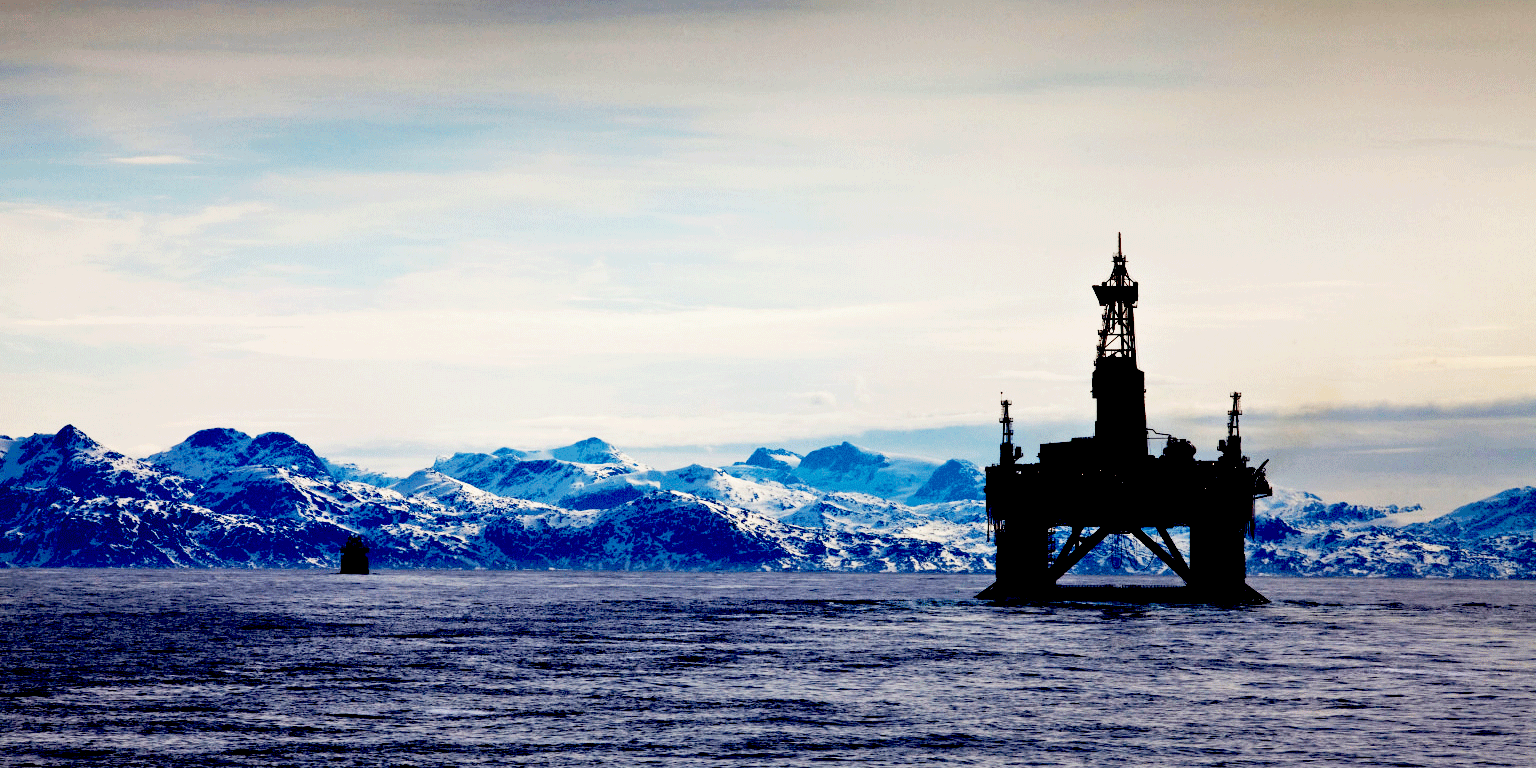
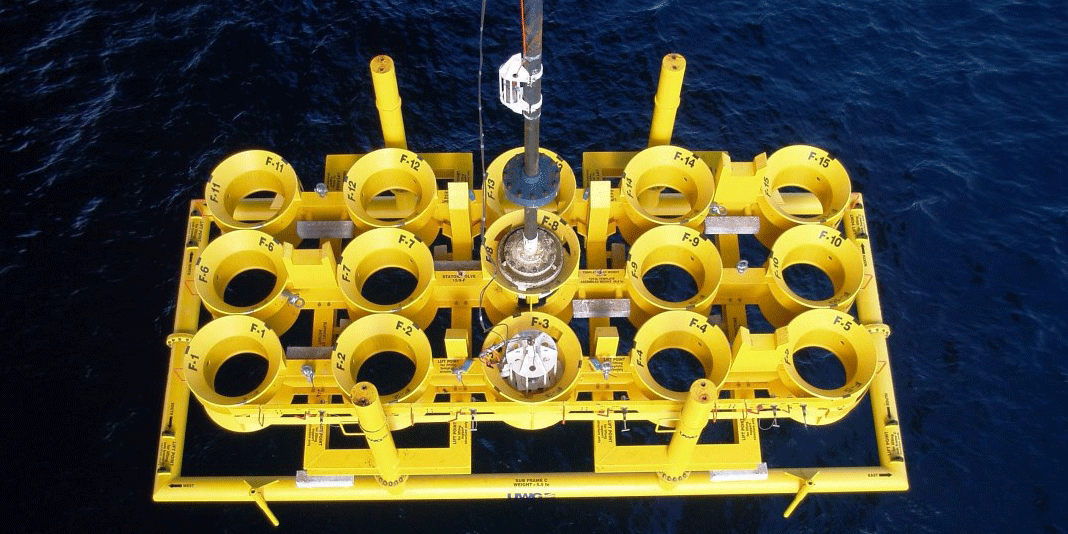 ▲海底钻井的整体式底盘
▲海底钻井的整体式底盘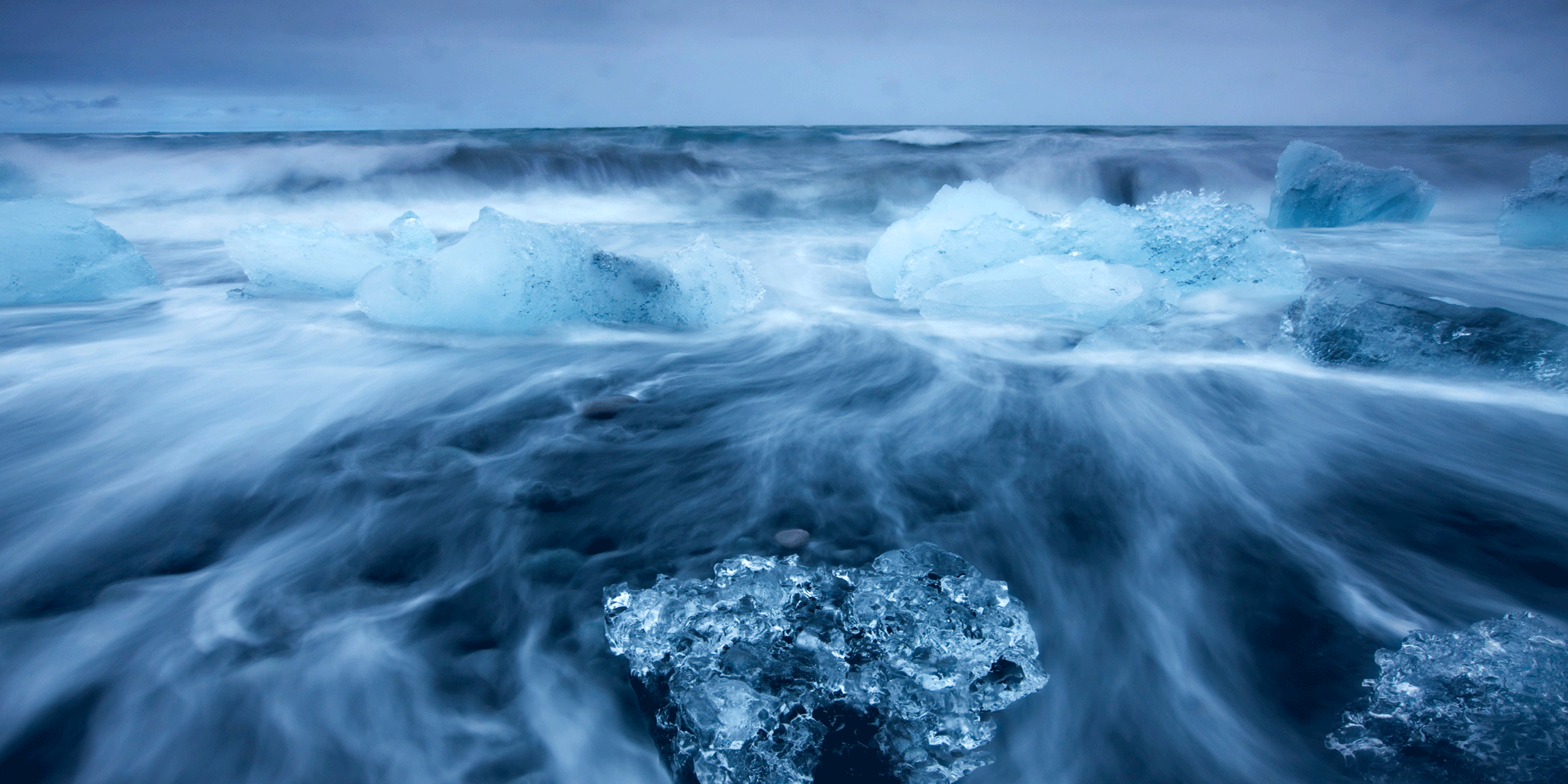
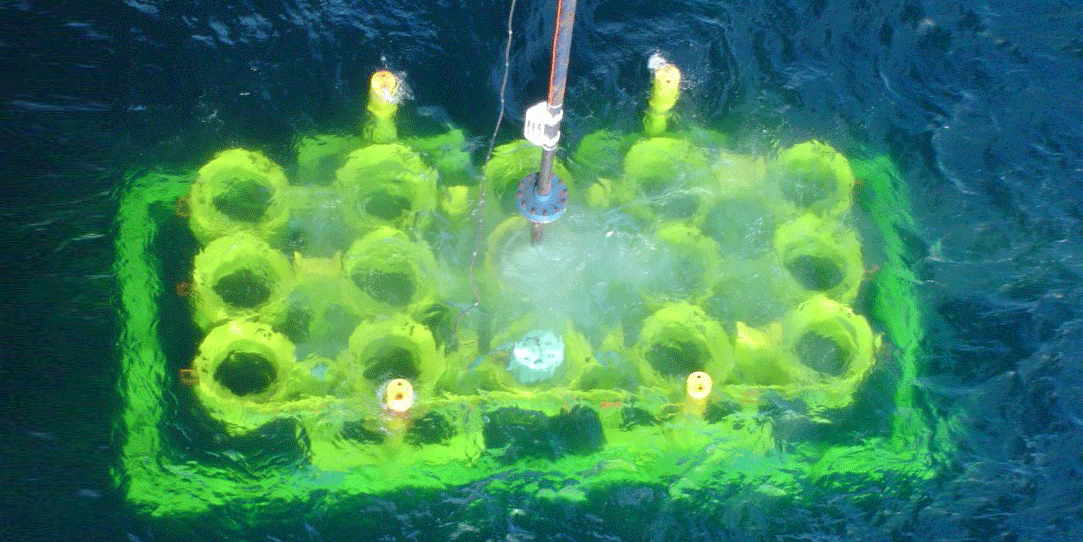 ▲海底钻井整体式底盘的安装过程
▲海底钻井整体式底盘的安装过程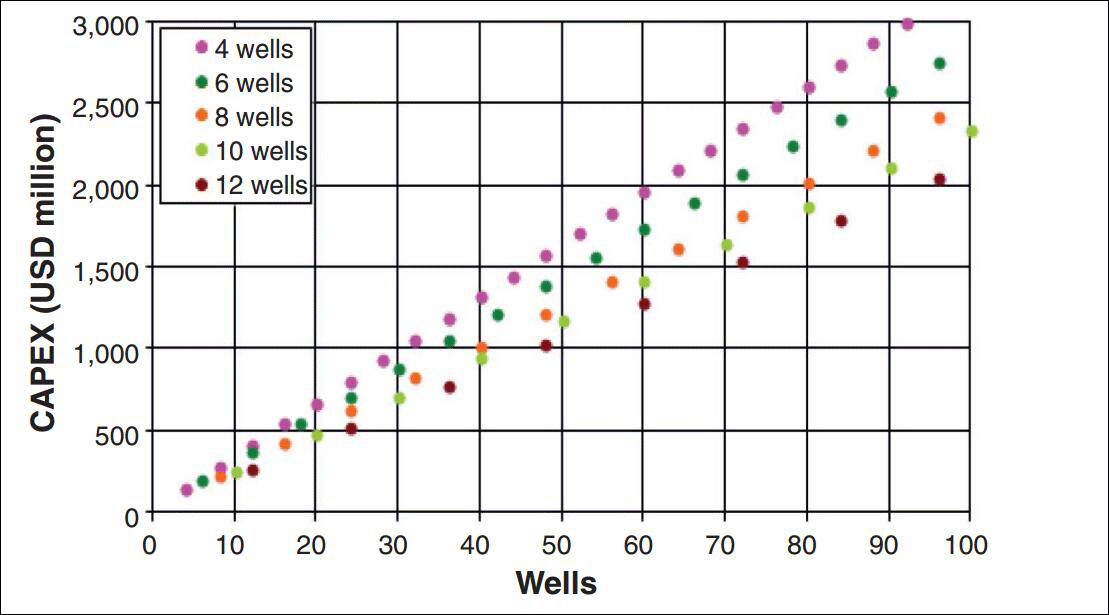 ▲整体式底盘建造费用(费用-油井数量)。底盘的建造费用可以通过不同井槽组块的倾斜角大小来进行判断。并且,如果预先知道底盘的数目,可以很容易的计算出底盘的建造费用,井槽数多的组块的总体建造成本较低。
▲整体式底盘建造费用(费用-油井数量)。底盘的建造费用可以通过不同井槽组块的倾斜角大小来进行判断。并且,如果预先知道底盘的数目,可以很容易的计算出底盘的建造费用,井槽数多的组块的总体建造成本较低。.gif) ▲表1 Shtokman项目油田开发第一阶段整体式底盘费用
▲表1 Shtokman项目油田开发第一阶段整体式底盘费用.gif) ▲表2 FDE程序的输出结果
▲表2 FDE程序的输出结果
 石油圈
石油圈